click on the home button to go to the home page
|
The Industrial Era 1958 - 1960 The Third Generation of computers starts approximately in this era. These computers are characterized by mainly electronic models but now fully programmable. The invention of the IC technology starts the third generation of computers. |
pre history | antiquity | pre industrial era | industrial era
| Related Articles |
| Related Resources |
|
pre history |
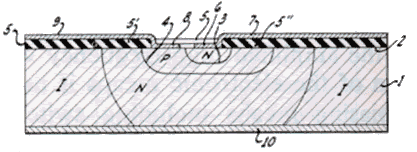
![]() The
first 'flat transistor' is designed by Jean
Hoerni et al. Flat because this form of the transistor consists of layers
of thin semi conductor material.
The
first 'flat transistor' is designed by Jean
Hoerni et al. Flat because this form of the transistor consists of layers
of thin semi conductor material.
![]() Jean
Hoerni, Kurt Lehovec, and
Robert N. Noyce at Fairchild laboratories
took part in the development of the Integrated
Circuit - a circuit on a single slice of silicon. The illustration above shows
a technical drawing from the patent Hoerni, Lehovec, and Noyce submitted. In
this case it is a so called NPN type of transistor - negative - positive - negative
layered.
Jean
Hoerni, Kurt Lehovec, and
Robert N. Noyce at Fairchild laboratories
took part in the development of the Integrated
Circuit - a circuit on a single slice of silicon. The illustration above shows
a technical drawing from the patent Hoerni, Lehovec, and Noyce submitted. In
this case it is a so called NPN type of transistor - negative - positive - negative
layered.
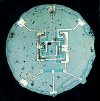
In 1959 they will complete the project successfully. In 1961 the first commercial Integrated Circuit will be put on the market.
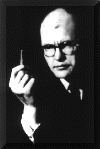
![]() In
December Jack St. Clair Kilby at
Texas
Instruments completed building the first IC (integrated circuit), containing
five components on a piece of germanium measuring half an inch long and thinner
than a toothpick(3)
In
December Jack St. Clair Kilby at
Texas
Instruments completed building the first IC (integrated circuit), containing
five components on a piece of germanium measuring half an inch long and thinner
than a toothpick(3)
It is generally accepted that both teams at Fairchild and Texas Instruments developed the IC independently.
![]() The first virtual
memory machine, Atlas, is installed in England by Ferranti. Developed at the
University of Manchester under management of R.M. Kilburn.
The first virtual
memory machine, Atlas, is installed in England by Ferranti. Developed at the
University of Manchester under management of R.M. Kilburn.
![]() ALGOL:
ALGOrithmic Language - first called: International Algebraic Language
- was designed. It took until 1960 before there was a formal syntax, because
of that the language will be called ALGOL 60. ALGOL was a generic name for an
entire family of higher level computer languages. This language introduced the
concept of "block instructions", something we will learn to know as
procedures. This concept was picked up by Niclaus Wirth and that lead to PASCAL.
Wirth is also member of the ALGOL committee.
ALGOL:
ALGOrithmic Language - first called: International Algebraic Language
- was designed. It took until 1960 before there was a formal syntax, because
of that the language will be called ALGOL 60. ALGOL was a generic name for an
entire family of higher level computer languages. This language introduced the
concept of "block instructions", something we will learn to know as
procedures. This concept was picked up by Niclaus Wirth and that lead to PASCAL.
Wirth is also member of the ALGOL committee.
ALGOL broke away from the formula processing languages like Fortran. ALGOL however
was more popular in the USA than in Europe.
![]() FORTRAN II was
able to handle subroutines and links to assembly languages.
FORTRAN II was
able to handle subroutines and links to assembly languages.
![]() In Japan
a computer based on the principle of the parametron
was produced: HIPAC. The parametron principle was technological
a completely unknown phenomena. (see also 1954 and
Masusino and Principle
of Parametron). The machine has a magnetic drum as memory.
In Japan
a computer based on the principle of the parametron
was produced: HIPAC. The parametron principle was technological
a completely unknown phenomena. (see also 1954 and
Masusino and Principle
of Parametron). The machine has a magnetic drum as memory.

![]() In
Japan the parametron computer PC-1
is cinstructed, shown is the machine in the spring of 1958 when it was operating
but not yet completed. Eiichi Goto is on the right; Hidetosi Takahasi on the
left.(19)
In
Japan the parametron computer PC-1
is cinstructed, shown is the machine in the spring of 1958 when it was operating
but not yet completed. Eiichi Goto is on the right; Hidetosi Takahasi on the
left.(19)

![]() The
IBM 7000 machine was the the first fully transistorized
mainframes built in series. This generation
is five times faster than their brethren of the same class of computers with
vacuum tubes. The original development that started with the Whirlwind project
became a reality in 1958 with the installation of the SAGE system for
Air Defense at McGuire AFB in NJ. The first effective air traffic control system
was operational for the northeastern US.
The
IBM 7000 machine was the the first fully transistorized
mainframes built in series. This generation
is five times faster than their brethren of the same class of computers with
vacuum tubes. The original development that started with the Whirlwind project
became a reality in 1958 with the installation of the SAGE system for
Air Defense at McGuire AFB in NJ. The first effective air traffic control system
was operational for the northeastern US.
![]() The recently
founded Control Data Corporation under management of William Norris, created
their contribution to the supercomputer market with the fully transistorized
-- CDC 1604 -- Seymour Cray was the chief architect.
The recently
founded Control Data Corporation under management of William Norris, created
their contribution to the supercomputer market with the fully transistorized
-- CDC 1604 -- Seymour Cray was the chief architect.
![]() LISP
is developed on the IBM 704 at MIT under John McCarthy(19)
It is one of the languages used in the quest for Artificial Intelligence.
LISP
is developed on the IBM 704 at MIT under John McCarthy(19)
It is one of the languages used in the quest for Artificial Intelligence.
The programming language LISP was well suited for manipulating strings or symbols
and is called a non-numeric processing language. LISP is an interpreted language
mostly used in Artificial Intelligence applications (AI). A feature of LISP
is the use of brackets as delimiters. Over the years many versions of LISP will
be offered: MacLisp, ZetaLisp, ICI-Lisp, InterLisp.
Later students, changed the meaning of LISP, standing for LISt Processing, into
"Lots of Idiotic, Silly Parentheses". (20)
![]() Frank Rosenblatt
builds the Perceptron Mark I using a CRT as an output device. (19)
Frank Rosenblatt
builds the Perceptron Mark I using a CRT as an output device. (19)
![]() At Bell Labs
the first modulator-demodulator device is developed that became known as "modem",
This modem had a speed of 300 baud(23, 6)
At Bell Labs
the first modulator-demodulator device is developed that became known as "modem",
This modem had a speed of 300 baud(23, 6)
![]() The first database
networking system is on RCA's BIZMAC computer. The machine could deal with one
subject and handle all stored data on that subject. To be able to do that without
changing tapes it had had maximum of 200 tapes to store data on.
The first database
networking system is on RCA's BIZMAC computer. The machine could deal with one
subject and handle all stored data on that subject. To be able to do that without
changing tapes it had had maximum of 200 tapes to store data on.
![]() By this year
over 200 programming languages have been created.(23)
By this year
over 200 programming languages have been created.(23)
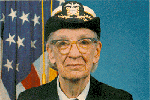
![]() At Poughkeepsie
(USA) engineers of IBM completed the first fully automated
production line to produce transistors. One year later 1800 transistors
per hour came off the production line and were tested at the same time as well.(2)
At Poughkeepsie
(USA) engineers of IBM completed the first fully automated
production line to produce transistors. One year later 1800 transistors
per hour came off the production line and were tested at the same time as well.(2)
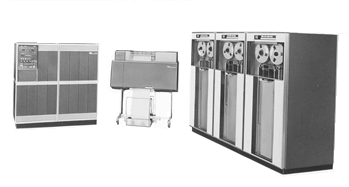
![]() While there was
a movement towards supercomputers in many companies, IBM announced the availability
of two smaller sized machines for the small user -- the IBM 1401 for the business
user and the IBM 1620 for the scientist. The 1401 became the most popular business
data processing machine, and for small universities and colleges, the 1620 became
the first computer experience for a many students. In six years time 10.000
1401 computers will be sold.
While there was
a movement towards supercomputers in many companies, IBM announced the availability
of two smaller sized machines for the small user -- the IBM 1401 for the business
user and the IBM 1620 for the scientist. The 1401 became the most popular business
data processing machine, and for small universities and colleges, the 1620 became
the first computer experience for a many students. In six years time 10.000
1401 computers will be sold.
Both machines introduced a character oriented core memory of 20-40k bytes in
which "word" boundaries could be defined by the programmer to provide
"unlimited precision". Both machines were supported by an arithmetic
unit that used a decimal table-look-up instead of binary adders. Initially IBM
intended to name the 1620 as the CADET, but when this was translated into "Can't
Add, Doesn't Even Try" the name was dropped.(20)
![]() IBM developed
a small nice program for their own employees: SPEAK UP
! It should improve the communication between employees.
IBM developed
a small nice program for their own employees: SPEAK UP
! It should improve the communication between employees.
![]() The DAC-1 (Design
Augmented by Computers) was created by Don Hart and Ed Jacks at General Motors
Research Laboratory and IBM. (Not unveiled until the Fall Joint Computer Conference
in Detroit in 1964.)(22) It was the first computer aided drawing
system.
The DAC-1 (Design
Augmented by Computers) was created by Don Hart and Ed Jacks at General Motors
Research Laboratory and IBM. (Not unveiled until the Fall Joint Computer Conference
in Detroit in 1964.)(22) It was the first computer aided drawing
system.
![]() After
several years of work General Electric Corporation delivered 32 ERMA (Electronic
Recording Machine -- Accounting) computing systems to the Bank of America
in California to rescue the banking industry from being swamped by the rapidly
increasing numbers of checks being used by an ever increasing clientele. Based
on a basic design by SRI, the ERMA system employed Magnetic Ink Character
Recognition (MICR). A special font was developed that made it possible.
After
several years of work General Electric Corporation delivered 32 ERMA (Electronic
Recording Machine -- Accounting) computing systems to the Bank of America
in California to rescue the banking industry from being swamped by the rapidly
increasing numbers of checks being used by an ever increasing clientele. Based
on a basic design by SRI, the ERMA system employed Magnetic Ink Character
Recognition (MICR). A special font was developed that made it possible.
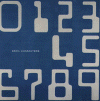


This system made capture data from the checks possible and a check handling
system was introduced that was not daunted by documents that were not in pristine
condition.
The banking industry rapidly became automated, introducing new ways of banking
including the ATM and electronic personal
banking. On the other hand it was a highlight in the history of computer manufacturing
at GE that, with the exception of developing a profitable line of machines for
NCR (the NCR 304), never really achieved the status that might be expected of
such a financial giant. (20)
![]() Xerox 914 was
the first office copier for sale.
Xerox 914 was
the first office copier for sale.
![]() First packaged
software program sold by Computer Science Corporation.(19)
First packaged
software program sold by Computer Science Corporation.(19)
![]() IBM delivered
the first four models of the first all-transistor computers to United States
Air Force. These were called 7090 series.(23)
IBM delivered
the first four models of the first all-transistor computers to United States
Air Force. These were called 7090 series.(23)
![]() Both Texas
Instruments (February) and Fairchild Semiconductor corporation (July) filed
for a patent for the process to produce transistors on a flat layer. This is
the process that will take the IC to mass production in about two years time.(3).
Both firms engaged in a legal battle that lasted through the decade of the 60's
until they decided to cross-license their technologies.(5)
Both Texas
Instruments (February) and Fairchild Semiconductor corporation (July) filed
for a patent for the process to produce transistors on a flat layer. This is
the process that will take the IC to mass production in about two years time.(3).
Both firms engaged in a legal battle that lasted through the decade of the 60's
until they decided to cross-license their technologies.(5)
![]() The IBM
700 series was the first to have a build in BIOS, called
IOCS (Input, Output
Control System). This IOCS made it possible to have multiple processes at
the same time. With this setup it became possible to operate a computer at a
distance and exchange data by ordinary telephone line. The first step on the
road to networks
is given!
The IBM
700 series was the first to have a build in BIOS, called
IOCS (Input, Output
Control System). This IOCS made it possible to have multiple processes at
the same time. With this setup it became possible to operate a computer at a
distance and exchange data by ordinary telephone line. The first step on the
road to networks
is given!
![]() William Fetter
of Boeing coined the term "computer graphics" for his human factors
cockpit drawings.(22)
William Fetter
of Boeing coined the term "computer graphics" for his human factors
cockpit drawings.(22)
![]() IBM developed
software for the ECHO project, communication via space or satellite transmission.
IBM developed
software for the ECHO project, communication via space or satellite transmission.
![]() In the early
60's the flight trajectory of NASA's Saturn was calculated an astonishing few
thousand times by an IBM 7090. That machine could do 22900 calculations per
second. This set the standard in the industry: the number of (floating point)
calculations per second: FLOPS
In the early
60's the flight trajectory of NASA's Saturn was calculated an astonishing few
thousand times by an IBM 7090. That machine could do 22900 calculations per
second. This set the standard in the industry: the number of (floating point)
calculations per second: FLOPS
|
IC classification To bring some order in the micro chips being made in hundreds of different kinds a classification was given to them according to how many transistors were integrated on one single chip: |
![]() Digital Equipment
Corp (DEC) released its first mini computer: PDP-1 priced
at 125,000 to 250,000 US$ depending on the configuration. The first in a family
of computers that became famous. The chief designer was Benjamin Curley
Digital Equipment
Corp (DEC) released its first mini computer: PDP-1 priced
at 125,000 to 250,000 US$ depending on the configuration. The first in a family
of computers that became famous. The chief designer was Benjamin Curley
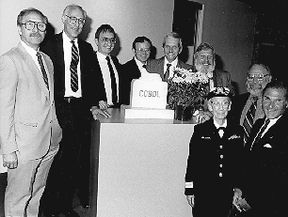
![]() Since
1952 Grace Murray Hopper (the little lady in uniform) had been developing a
series of programming languages that increasingly used natural language-like
phrases to express the operations of business data processing. FLOW MATIC was
the last of these. Others also had taken on the challenge, including IBM that
produced a language named COMMERCIAL TRANSLATOR. With these languages as a basis,
an industry-wide team -- Conference on Data System Languages (CODASYL) -- led
by Joe Wegstein of NBS (now NIST) developed a new language in a very short time
and created the first standardized business computer programming language, COBOL
(Common Business Oriented Language). For the next 20 years there will be more
programs written in COBOL than any other single language.(20)
Since
1952 Grace Murray Hopper (the little lady in uniform) had been developing a
series of programming languages that increasingly used natural language-like
phrases to express the operations of business data processing. FLOW MATIC was
the last of these. Others also had taken on the challenge, including IBM that
produced a language named COMMERCIAL TRANSLATOR. With these languages as a basis,
an industry-wide team -- Conference on Data System Languages (CODASYL) -- led
by Joe Wegstein of NBS (now NIST) developed a new language in a very short time
and created the first standardized business computer programming language, COBOL
(Common Business Oriented Language). For the next 20 years there will be more
programs written in COBOL than any other single language.(20)
![]() The second of
the mathematical languages, ALGOL 60 was developed, also by a committee. Although
not widely implemented ALGOL became the conceptual basis of many programming
languages thereafter
The second of
the mathematical languages, ALGOL 60 was developed, also by a committee. Although
not widely implemented ALGOL became the conceptual basis of many programming
languages thereafter
![]() Mark Rosenblatt
published his results on the Perceptron. This first
working model on neural networks was demonstrated on a MARK I machine. The Perceptron
program was capable of recognizing patterns. The demonstration showed that the
Perceptron program could recognize letters from the alphabet.
Mark Rosenblatt
published his results on the Perceptron. This first
working model on neural networks was demonstrated on a MARK I machine. The Perceptron
program was capable of recognizing patterns. The demonstration showed that the
Perceptron program could recognize letters from the alphabet.
But what Rosenblatt forgot to do was to massage the scientific community into
having an open mind to his far reaching ideas. As a result the scientific community
reacted not so scientifically and rejected his somewhat controversial ideas.
This was a real set back for the budding cognitive sciences(21).
![]() Removable disks
first appeared (19)
Removable disks
first appeared (19)
![]() IBM defined
PL/1 being a combination of ALGOL, FORTRAN, and COBOL. The new language was
used to write large application programs on large systems. (23)
IBM defined
PL/1 being a combination of ALGOL, FORTRAN, and COBOL. The new language was
used to write large application programs on large systems. (23)
![]() Heathkit brought
out the EC1 meant for educational purposes. It was the first Analogue computer
available to the public at an affordable price(25) app. 400
US$. The machine became very popular with engineers and at schools.
Heathkit brought
out the EC1 meant for educational purposes. It was the first Analogue computer
available to the public at an affordable price(25) app. 400
US$. The machine became very popular with engineers and at schools.
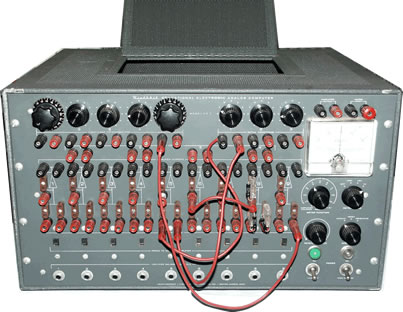
![]() The first commercial
modem was marketed: Bell Dataphone 103 with the speed of 300 Bps (bits per second
= appr 30 characters per second ) (8)
The first commercial
modem was marketed: Bell Dataphone 103 with the speed of 300 Bps (bits per second
= appr 30 characters per second ) (8)
![]()
| Last Updated on July 1, 2004 | For suggestions please mail the editors |
Footnotes & References